Transparent Polyaniline Thin Film Synthesized Using a Low-Voltage-Driven Atmospheric Pressure Plasma Reactor
Abstract
1. Introduction
2. Materials and Methods
2.1. The AP-Plasma Polymerization System
2.2. Characterizations of the AP-Plasma and the Deposited Polyaniline Thin Film
3. Results and Discussion
3.1. The AP-Plasma Reactor with a Bare Wire Electrode
3.2. Electrical and Optical Properties of the Plasma Produced by the Newly Designed Plasma Reactor
3.3. Characterization of the AP-Plasma Polymerized Aniline Thin Films
4. Conclusions
Author Contributions
Funding
Institutional Review Board Statement
Informed Consent Statement
Acknowledgments
Conflicts of Interest
References
- Friedrich, J. Mechanisms of plasma polymerization—Reviewed from a chemical point of view. Plasma Process. Polym. 2011, 8, 783–802. [Google Scholar] [CrossRef]
- Williams, T.; Hayes, M.W. Polymerization in a glow discharge. Nature 1966, 209, 769–773. [Google Scholar] [CrossRef]
- Stille, J.K.; Sung, R.L.; Vander Kooi, J. The reaction of benzene in a radiofrequency glow discharge. J. Org. Chem. 1965, 30, 3116–3119. [Google Scholar] [CrossRef]
- Jesch, K.; Bloor, J.E.; Kronick, P.L. Structure and physical properties of glow discharge polymers. I. Polymers from hydrocarbons. J. Polym. Sci. 1966, A1, 1487–1497. [Google Scholar] [CrossRef]
- Yasuda, H.; Hsu, T. Some aspects of plasma polymerization investigated by pulsed R.F. discharge. J. Polym. Sci. Polym. Chem. Ed. 1977, 15, 81–97. [Google Scholar] [CrossRef]
- Coulson, S.R.; Woodward, I.S.; Badyal, J.P.S.; Brewer, S.A.; Willis, C. Ultralow surface energy plasma polymer films. Chem. Mater. 2000, 12, 2031–2038. [Google Scholar] [CrossRef]
- Denes, F.S.; Manolache, S. Macromolecular plasma-chemistry: An emerging field of polymer science. Prog. Polym. Sci. 2004, 29, 815–885. [Google Scholar] [CrossRef]
- Petersen, J.; Becker, C.; Fouquet, T.; Addiego, F.; Toniazzo, V.; Dinia, A.; Ruch, D. Nano-ordered thin films achieved by soft atmospheric plasma polymerization. RSC Adv. 2013, 3, 4416–4424. [Google Scholar] [CrossRef]
- Jatratkar, A.A.; Yadav, J.B.; Deshmukh, R.R.; Barshilia, H.C.; Puri, V.; Puri., R.K. Glow discharge plasma polymerized nanostructured polyaniline thin film optical waveguide. Adv. Mater. Lett. 2017, 8, 180–184. [Google Scholar] [CrossRef]
- Ramkumar, M.C.; Pandiyaraj, K.N.; Kumar, A.A.; Padmanabhan, P.V.A.; Kumar, S.U.; Gopinath, P.; Bendavid, A.; Cools, P.; De Geyter, N.; Morent, R.; et al. Evaluation of mechanism of cold atmospheric pressure plasma assisted polymerization of acrylic acid on low density polyethylene (LDPE) film surfaces: Influence of various gaseous plasma pretreatment. Appl. Surf. Sci. 2018, 439, 991–998. [Google Scholar] [CrossRef]
- Park, C.-S.; Kim, D.H.; Shin, B.J.; Tae, H.-S. Synthesis and characterization of nanofibrous polyaniline thin film prepared by novel atmospheric pressure plasma polymerization technique. Materials 2016, 9, 39. [Google Scholar] [CrossRef]
- Park, C.-S.; Jung, E.Y.; Kim, D.H.; Cho, B.-G.; Shin, B.J.; Tae, H.-S. TOF-SIMS study on nano size conducting polymer prepared by simple atmospheric pressure plasma polymerization technique for display applications. Mol. Cryst. Liq. Cryst. 2017, 651, 16–25. [Google Scholar] [CrossRef]
- Park, C.-S.; Kim, D.Y.; Kim, D.H.; Lee, H.-K.; Shin, B.J.; Tae, H.-S. Humidity-independent conducting polyaniline films synthesized using advanced atmospheric pressure plasma polymerization with in-situ iodine doping. Appl. Phys. Lett. 2017, 110, 033502. [Google Scholar] [CrossRef]
- Park, C.-S.; Jung, E.Y.; Kim, D.H.; Kim, D.Y.; Lee, H.-K.; Shin, B.J.; Lee, D.H.; Tae, H.-S. Atmospheric pressure plasma polymerization synthesis and characterization of polyaniline films doped with and without iodine. Materials 2017, 10, 1272. [Google Scholar] [CrossRef]
- Kim, D.H.; Park, C.-S.; Jung, E.Y.; Shin, B.J.; Kim, J.Y.; Bae, G.T.; Jang, H.J.; Cho, B.-G.; Tae, H.-S. Effects of iodine dopant on atmospheric pressure plasma polymerized pyrrole in remote and coupling methods. Mol. Cryst. Liq. Cryst. 2018, 677, 135–142. [Google Scholar] [CrossRef]
- Kim, D.H.; Park, C.-S.; Jung, E.Y.; Kum, D.S.; Kim, J.Y.; Kim, D.; Bae, G.T.; Cho, B.-G.; Shin, B.J.; Lee, D.H.; et al. Experimental study on atmospheric pressure plasma polymerized conducting polymer under coupling and remote conditions. Mol. Cryst. Liq. Cryst. 2018, 663, 108–114. [Google Scholar] [CrossRef]
- Jang, H.J.; Park, C.-S.; Jung, E.Y.; Bae, G.T.; Shin, B.J.; Tae, H.-S. Synthesis and properties of thiophene and aniline copolymer using atmospheric pressure plasma jets copolymerization technique. Polymers 2020, 12, 2225. [Google Scholar] [CrossRef] [PubMed]
- Kim, J.Y.; Iqbal, S.; Jang, H.J.; Jung, E.Y.; Bae, G.T.; Park, C.-S.; Tae, H.-S. In-situ iodine doping characteristics of conductive polyaniline film polymerized by low-voltage-driven atmospheric pressure plasma. Polymers 2021, 13, 418. [Google Scholar] [CrossRef]
- Teschke, M.; Kedzierski, J.; Finantu-Dinu, E.G.; Korzec, D.; Engemann, J. High-speed photographs of a dielectric barrier atmospheric pressure plasma jet. IEEE Trans. Plasma Sci. 2005, 33, 310–311. [Google Scholar] [CrossRef]
- Lu, X.; Jiang, Z.; Xiong, Q.; Tang, Z.; Hu, X.; Pan, Y. An 11 cm long atmospheric pressure cold plasma plume for applications of plasma medicine. Appl. Phys. Lett. 2008, 92, 081502. [Google Scholar] [CrossRef]
- Lia, Q.; Li, J.-T.; Zhu, W.-C.; Zhu, X.-M.; Pu, Y.-K. Effects of gas flow rate on the length of atmospheric pressure nonequilibrium plasma jets. Appl. Phys. Lett. 2009, 95, 141502. [Google Scholar] [CrossRef]
- Sands, B.L.; Huang, S.K.; Ganguly, B.N. Current scaling in an atmospheric pressure capillary dielectric barrier discharge. Appl. Phys. Lett. 2009, 95, 051502. [Google Scholar] [CrossRef]
- Nguyen, D.B.; Trinh, Q.H.; Mok, Y.S.; Lee, W.G. Generation of cold atmospheric plasma jet by a coaxial double dielectric barrier reactor. Plasma Sources Sci. Technol. 2020, 29, 035014. [Google Scholar] [CrossRef]
- Staack, D.; Farouk, B.; Gutsol, A.; Fridman, A. Characterization of a dc atmospheric pressure normal glow discharge. Plasma Sources Sci. Technol. 2005, 14, 700–711. [Google Scholar] [CrossRef]
- Staack, D.; Farouk, B.; Gutsol, A.; Fridman, A. DC normal glow discharges in atmospheric pressure atomic and molecular gases. Plasma Sources Sci. Technol. 2008, 17, 025013. [Google Scholar] [CrossRef]
- Li, X.; Bao, W.; Jia, P.; Di, C. A brush-shaped air plasma jet operated in glow discharge mode at atmospheric pressure. J. Appl. Phys. 2014, 116, 023302. [Google Scholar] [CrossRef]
- Jiang, W.; Tang, J.; Wang, Y.; Zhao, W.; Duan, Y. Characterization of argon direct-current glow discharge with a longitudinal electric field applied at ambient air. Sci. Rep. 2014, 4, 6323. [Google Scholar] [CrossRef] [PubMed]
- Majeed, A.; Zhong, X.; Xu, S.; Wu, X.; Cvelbar, U.; Sheng, Z. The influence of discharge capillary size, distance, and gas composition on the non-equilibrium state of microplasma. Plasma Process. Polym. 2016, 13, 690–697. [Google Scholar] [CrossRef]
- Li, X.; Zhang, P.; Jia, P.; Chu, J.; Chen, J. Generation of a planar direct-current glow discharge in atmospheric pressure air using rod array electrode. Sci. Rep. 2017, 7, 2672. [Google Scholar] [CrossRef] [PubMed]
- Fu, Y.; Zhang, P.; Verboncoeur, J.P.; Christlieb, A.J.; Wang, X. Effect of surface protrusion on plasma sheath properties in atmospheric microdischarges. Phys. Plasmas 2018, 25, 013530. [Google Scholar] [CrossRef]
- Fu, Y.; Krek, J.; Zhang, P.; Verboncoeur, J.P. Gas breakdown in microgaps with a surface protrusion on the electrode. IEEE Trans. Plasma Sci. 2019, 47, 2011–2019. [Google Scholar] [CrossRef]
- Sharma, A.K.; Bhardwaj, P.; Dhawan, S.K.; Sharma, Y. Oxidative synthesis and electrochemical studies of poly(aniline-co-pyrrole)-hybrid carbon nanostructured composite electrode materials for supercapacitor. Adv. Mater. Lett. 2015, 6, 414–420. [Google Scholar] [CrossRef]
- Mathai, C.J.; Saravanan, S.; Anantharaman, M.R.; Venkitachalam, S.; Jayalekshmi, S. Effect of iodine doping on the bandgap of plasma polymerized aniline thin films. J. Phys. D Appl. Phys. 2002, 35, 2206–2210. [Google Scholar] [CrossRef]
- Srinivasan, P.; Gottam, R. Infrared Spectra: Useful technique to identify the conductivity level of emeraldine form of polyaniline and indication of conductivity measurement either two or four probe technique. Mat. Sci. Res. India 2018, 15, 209–217. [Google Scholar] [CrossRef]
- Botewad, S.N.; Pahurkar, V.G.; Muley, G.G. Fabrication and evaluation of evanescent wave absorption based polyaniline-cladding modified fiber optic urea biosensor. Opt. Fiber Technol. 2018, 40, 8–12. [Google Scholar] [CrossRef]
- Wang, S.; Zhou, Y.; Liu, Y.; Wang, L.; Gao, C. Enhanced thermoelectric properties of polyaniline/polypyrrole/carbon nanotube ternary composites by treatment with a secondary dopant using ferric chloride. J. Mater. Chem. C 2020, 8, 528–535. [Google Scholar] [CrossRef]
- Su, N. Improving electrical conductivity, thermal stability, and solubility of polyaniline-polypyrrole nanocomposite by doping with anionic spherical polyelectrolyte brushes. Nanoscale Res. Lett. 2015, 10, 301. [Google Scholar] [CrossRef]
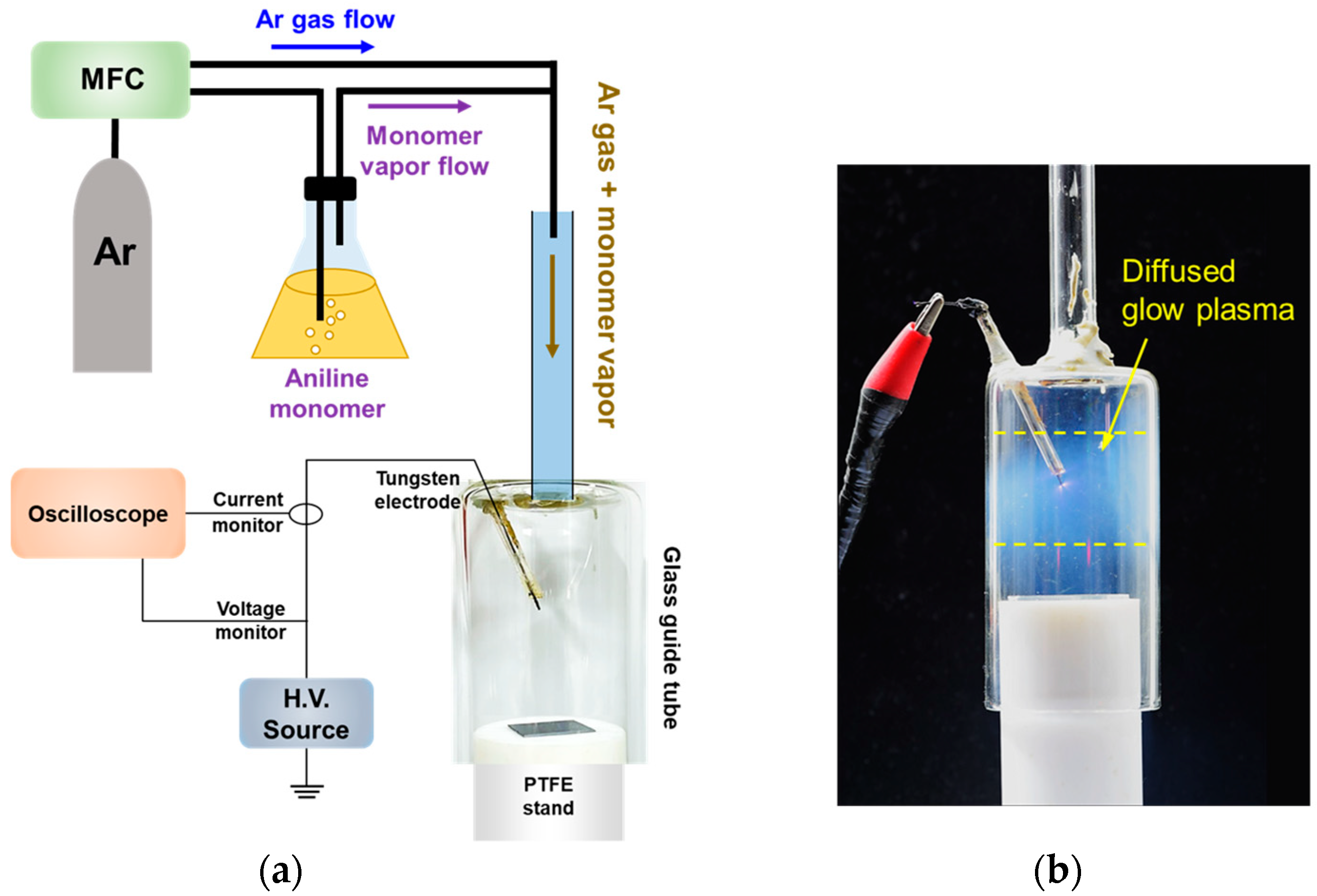

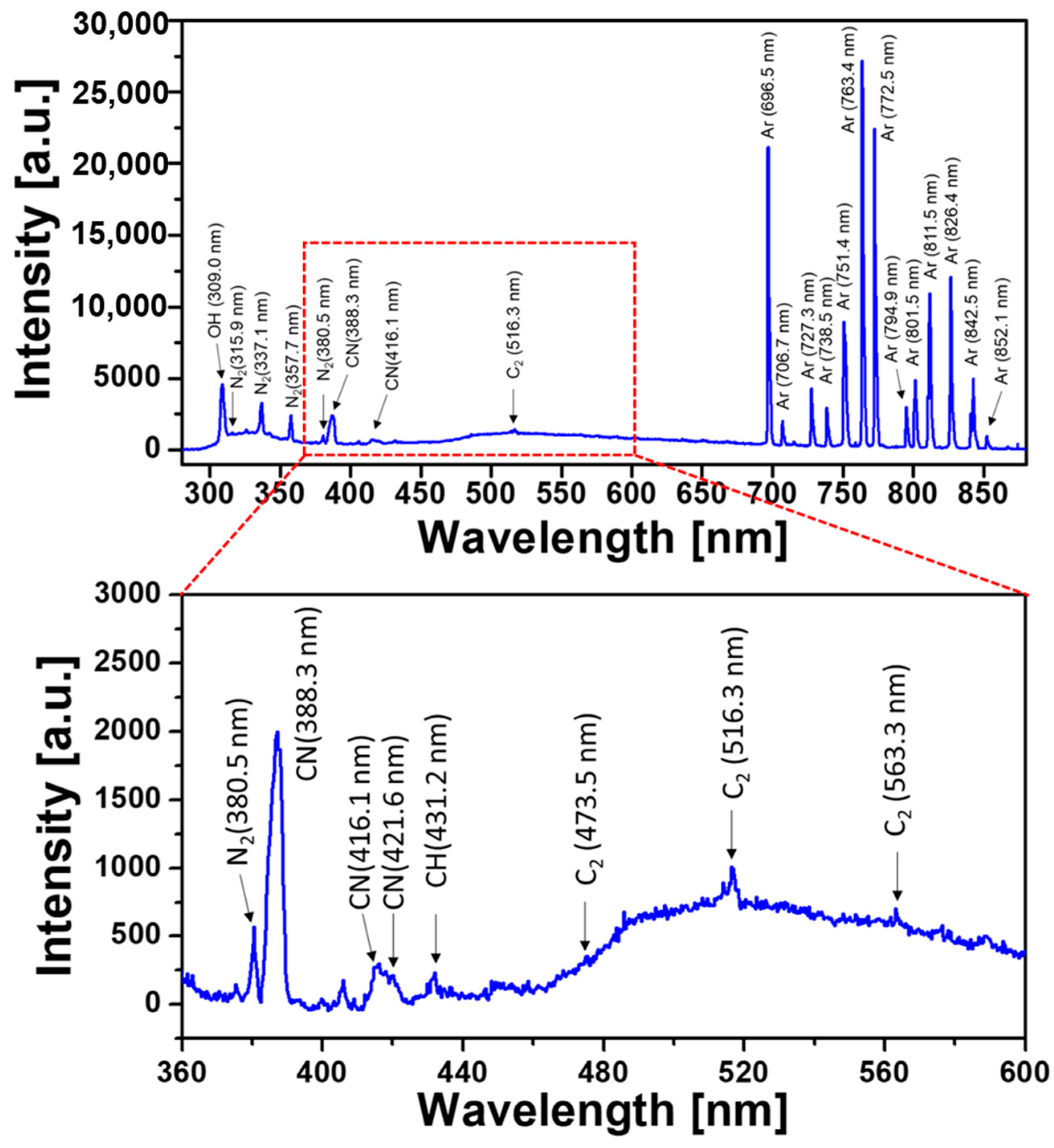
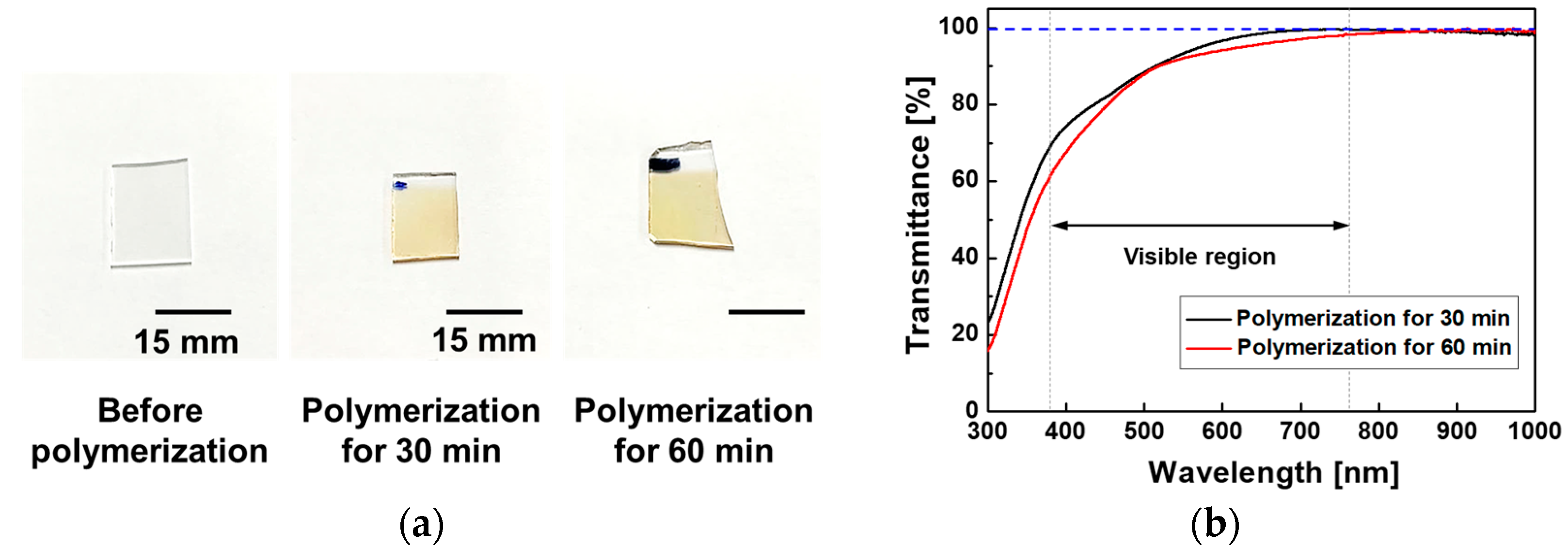

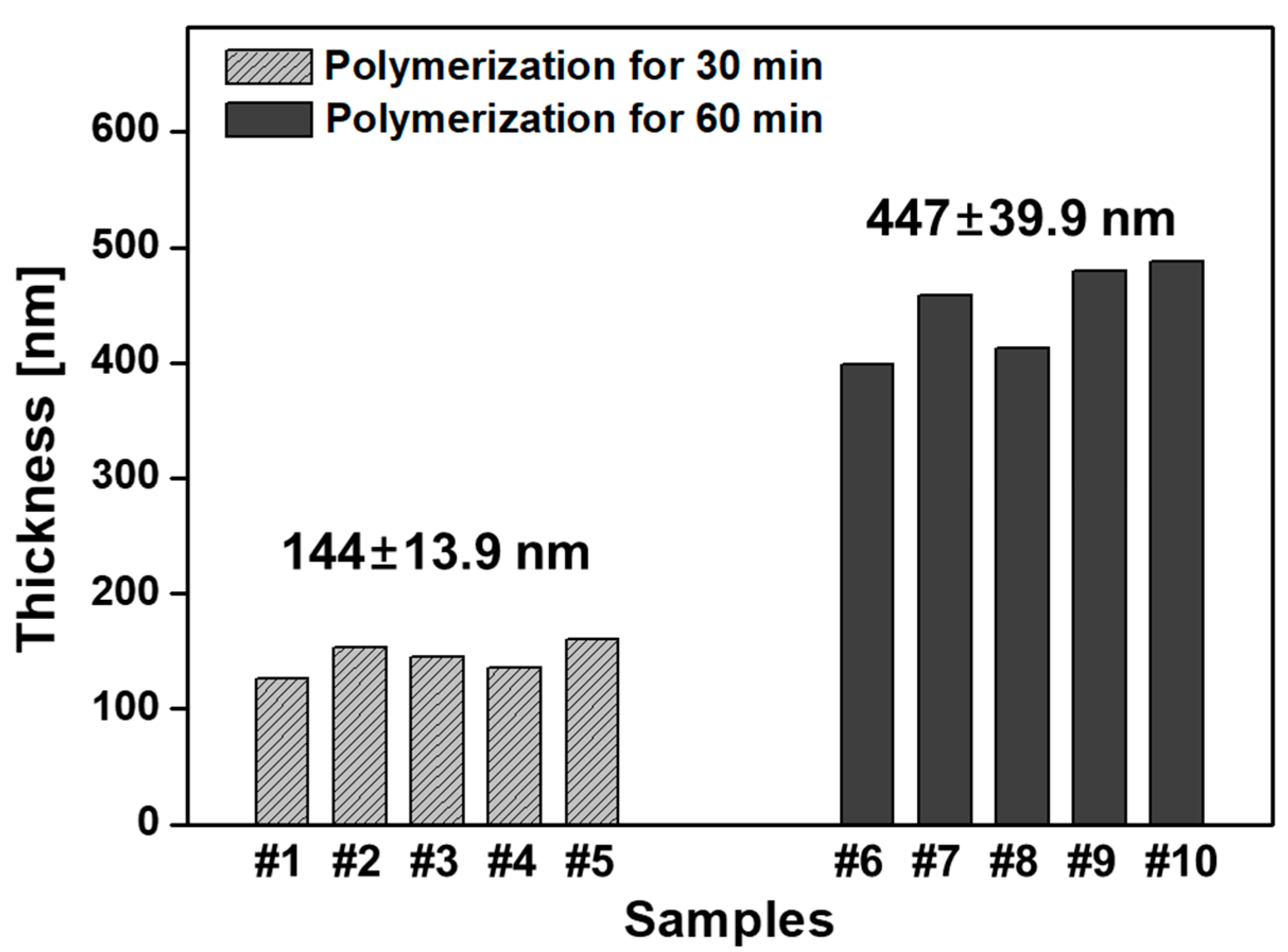
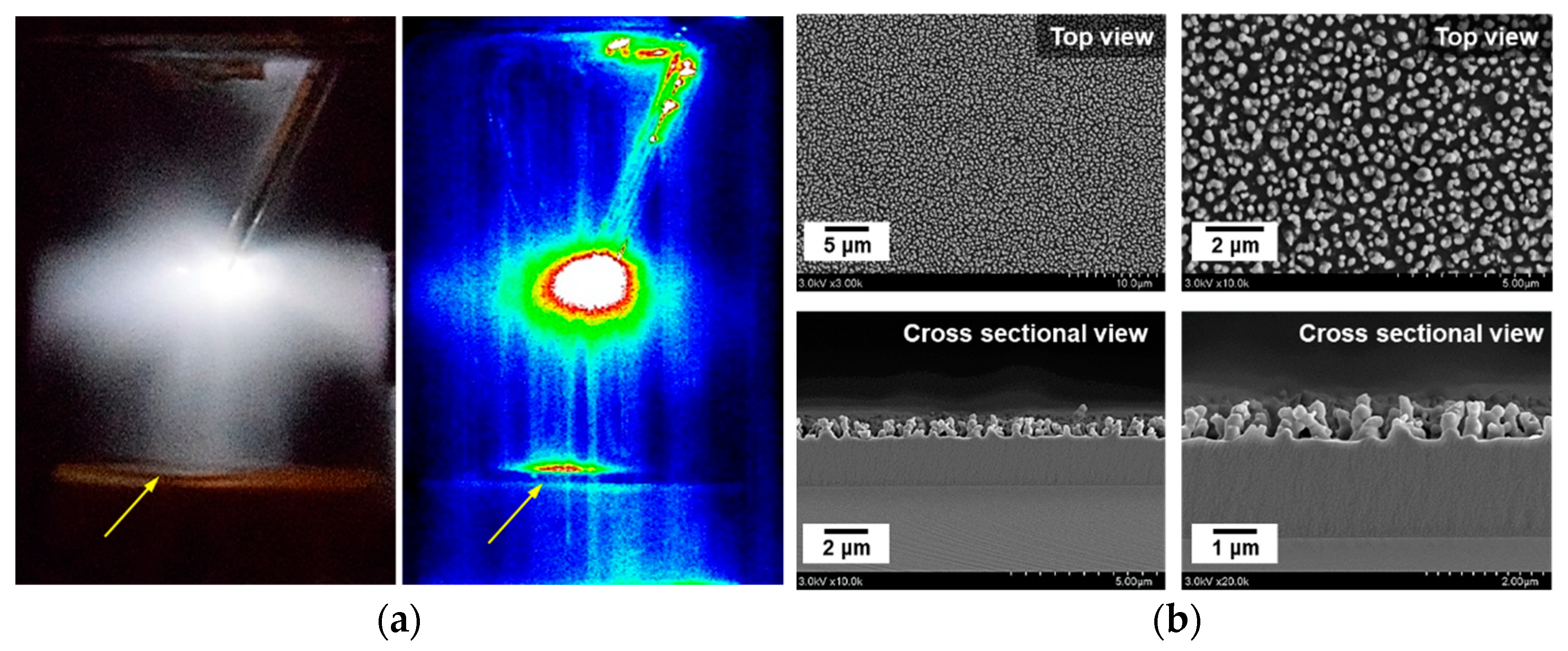
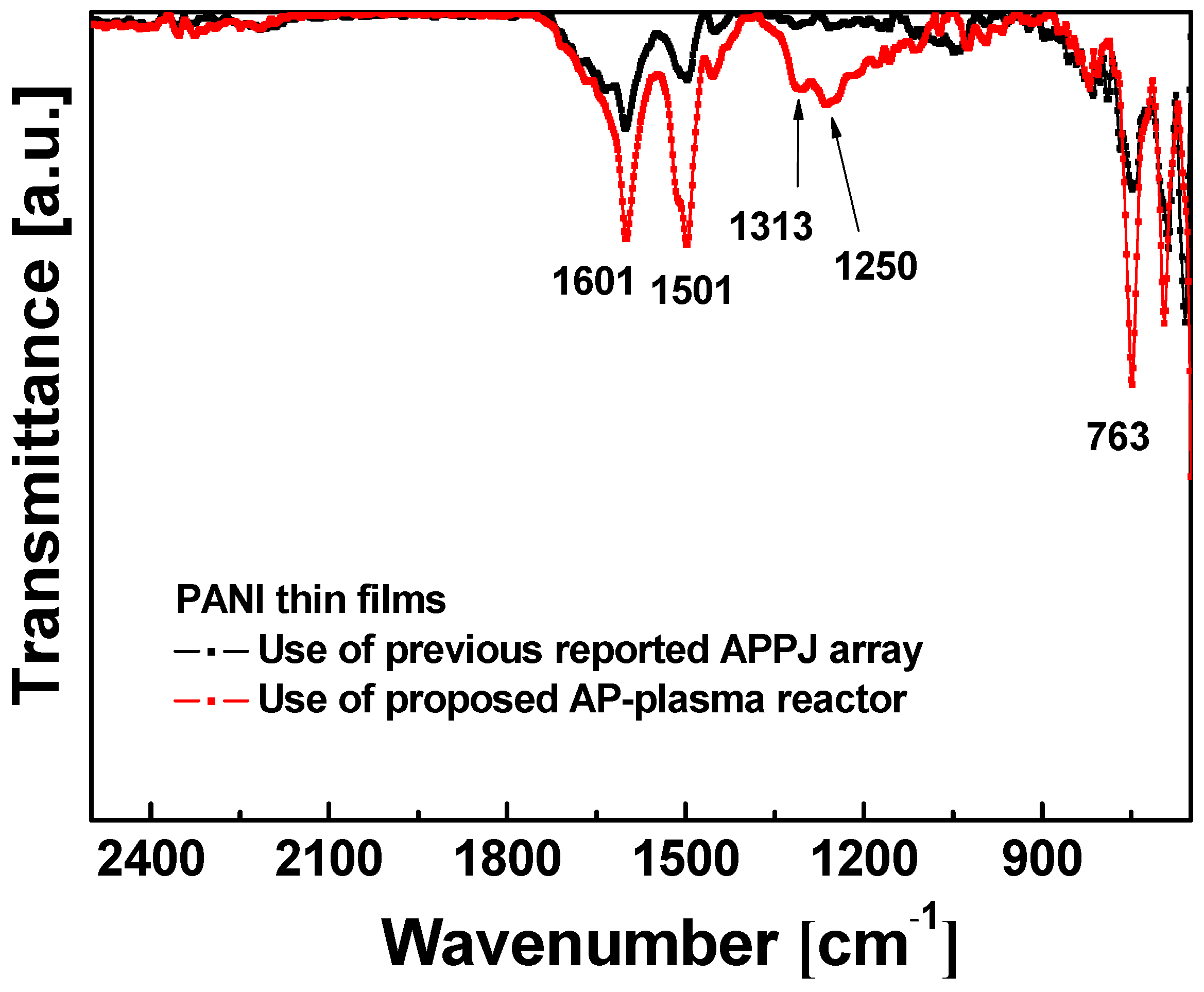
| Experimental Conditions | Previously Reported AP-Plasma Jet Array | Newly Designed AP-Plasma Reactor | |
|---|---|---|---|
| Device Configuration | Electrode type | Single electrode | Single electrode |
| Electrode material | Copper tape | Tungsten wire | |
| Use of dielectric barrier | Yes | No | |
| Diameter of wide tube | 20 mm | 34 mm | |
| Diameter of substrate stand | 15 mm | 30 mm | |
| Driving Conditions | Driving type | AC | AC |
| Voltage waveform | Sinusoidal | Sinusoidal | |
| Plasma initiation voltage (Vp) | 12 kV | 2.8 kV | |
| Plasma driving voltage (Vp) | 8 kV | 4 kV | |
| Driving frequency | 26 kHz | 30 kHz | |
| Average power dissipated (PRMS) 1 | 50.03 W | 12.00 W | |
| Gas Conditions | Gas type | Ar | Ar |
| Gas purity | HP grade (99.999%) | HP grade (99.999%) | |
| Flow rate for discharge | 1700 sccm | 1300 sccm | |
| Flow rate for vaporization | 160 sccm | 400 sccm | |
Publisher’s Note: MDPI stays neutral with regard to jurisdictional claims in published maps and institutional affiliations. |
© 2021 by the authors. Licensee MDPI, Basel, Switzerland. This article is an open access article distributed under the terms and conditions of the Creative Commons Attribution (CC BY) license (http://creativecommons.org/licenses/by/4.0/).
Share and Cite
Kim, J.Y.; Iqbal, S.; Jang, H.J.; Jung, E.Y.; Bae, G.T.; Park, C.S.; Shin, B.J.; Tae, H.S. Transparent Polyaniline Thin Film Synthesized Using a Low-Voltage-Driven Atmospheric Pressure Plasma Reactor. Materials 2021, 14, 1278. https://doi.org/10.3390/ma14051278
Kim JY, Iqbal S, Jang HJ, Jung EY, Bae GT, Park CS, Shin BJ, Tae HS. Transparent Polyaniline Thin Film Synthesized Using a Low-Voltage-Driven Atmospheric Pressure Plasma Reactor. Materials. 2021; 14(5):1278. https://doi.org/10.3390/ma14051278
Chicago/Turabian StyleKim, Jae Young, Shahzad Iqbal, Hyo Jun Jang, Eun Young Jung, Gyu Tae Bae, Choon Sang Park, Bhum Jae Shin, and Heung Sik Tae. 2021. "Transparent Polyaniline Thin Film Synthesized Using a Low-Voltage-Driven Atmospheric Pressure Plasma Reactor" Materials 14, no. 5: 1278. https://doi.org/10.3390/ma14051278
APA StyleKim, J. Y., Iqbal, S., Jang, H. J., Jung, E. Y., Bae, G. T., Park, C. S., Shin, B. J., & Tae, H. S. (2021). Transparent Polyaniline Thin Film Synthesized Using a Low-Voltage-Driven Atmospheric Pressure Plasma Reactor. Materials, 14(5), 1278. https://doi.org/10.3390/ma14051278









